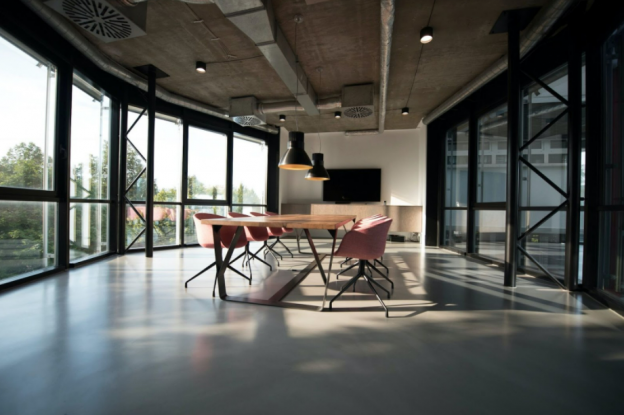Like so many sectors, the commercial office space took some massive blows during the pandemic, and it’s fair to say at this point that it seems forever changed. In particular, a recent study has outlined that Covid-19 brought about the worst recession in history regarding the office sector. It’s been an incredibly tough time for commercial property owners, as they battle to keep tenants, manage multiple Covid-related challenges, and entice new occupants back.
So, just how has the commercial office sector been impacted, and what trends are in effect to restore its strength?
New office designs
The heat is on for commercial space owners, with so much focus now being given to the future of office spaces and how vital it is to adopt new working models. As a result, some companies have opted to enforce a return to normal office schedules. In contrast, others have surrendered to the fact that a shift towards flexible working practices will outlive the pandemic and may factor heavily into recruiting and retention moving forward.
Many businesses are committed to exploring new ways to make their office environments and culture attractive to existing and future employees. Some are focused primarily on the physical attributes of the office, including enhanced amenities and security.
More attention is also being given to designing spaces that can accommodate hybrid working and proactive programming that promotes the most efficient use of the space.
Prioritizing safety
Occupancy management and superior access control systems are being adopted at pace, with so much heightened attention being placed upon health, safety, and security.
High-tech, cloud-based systems that allow for occupancy tracking all go towards the efficient management of commercial space and greater peace of mind and seamless experience for staff and visitors. As they prepare for an influx of people, tenants and landlords are in the process of reassessing their technologies and policies to best reflect new expectations of safety and security. As well as installing modernized security systems, various policies are being introduced, such as occupancy limits and distancing guidelines, and improvements, such as ventilation systems and hygienic surfaces are being carried out.
There is a significant increase in the adoption of office hoteling software that incorporates occupancy tracking. This software assists in streamlining employee communication and helps to plan and manage space utilization to ensure compliance and optimal occupancy metrics. There are multiple reasons for such an increase in the uptake of this technology, as they not only assist with the efficient return to the office post-Covid, but they also assist greatly in the transitioning to and management of hybrid and flexible work spaces. It is far easier to make cost-effective decisions for a workplace when in-office attendance tracking and desk sharing management is centralized by cutting-edge software. The insights gleaned by this technology is invaluable to the optimal management of modern workplaces.
Greater flexibility in lease structures
Given ongoing covid concerns and a persistent shift towards remote and hybrid working, it’s no surprise that many CRE (commercial real estate) tenants are seeking more short-term and flexible lease structures.
Still, new leases have been less impacted than you might expect. Recent statistics indicate that more than 75% of new office leases secured in the first half of 2021 were for terms exceeding four years, and 25% included terms of 10 years or more. It may not be until larger, existing office leases come up for renewal that we can assess the full impact of the pandemic.
Open plan layouts
Despite claims that open-plan office layouts lead to a reduction in productivity, they are the perfect solution to the post-pandemic office comeback. The trend towards open floor plans for offices makes sense given the challenges brought about by Covid-19. Open office space is much easier to clean, and avoiding so many closed-off areas significantly reduces the number of surfaces that each employee needs to touch in the course of a day. Additionally, given the knowledge that proper ventilation is critical in preventing the spread of Covid-19 (and other pathogens), having an open plan floor space can significantly improve the office’s ventilation, especially if it’s as simple as opening up some windows.
Many unconventional changes
While some enterprises may try to fight it, the way we fundamentally work is changing, and unconventional office spaces are the future.
As soon as the trend towards an ongoing preference for remote working began to emerge, office space landlords and tenants knew that many changes lay ahead. Of course, office spaces are still a vital component for many businesses, with face-to-face connections and collaborations fueling much of the morale and productivity of many professional teams. But the era of every business expecting its entire workforce to be in physical attendance for a full work week is behind us.
Hybrid workstations and spaces designed to incorporate multiple uses are growing in popularity, as tenants fight to maximize the economical use of expensive CRE while continuing to attract and retain the right professional talent.
Continued evolution pivotal to survival of the sector.
The pandemic has brought about a revolution in how we think about work environments, and sector landlords and tenants have to evolve their spaces to keep up. It’s simply not as clear-cut as adapting to some additional policies to adhere to pandemic-related issues. Covid-19 created such disruption and brought about so much reflection regarding the quality of our life and work habits, that a whole new era of expectations is upon us.
Need office space? Checkout OfficeFinder to find out how to get help in finding the perfect space for your business, for FREE. Message us.

